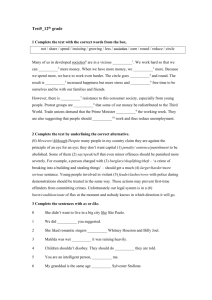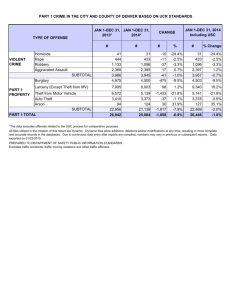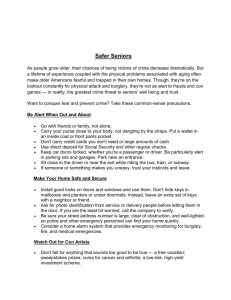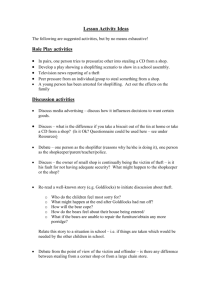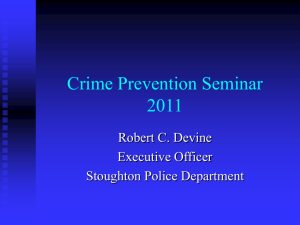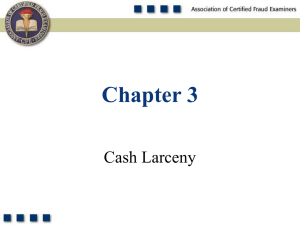Chapter Eleven:
advertisement
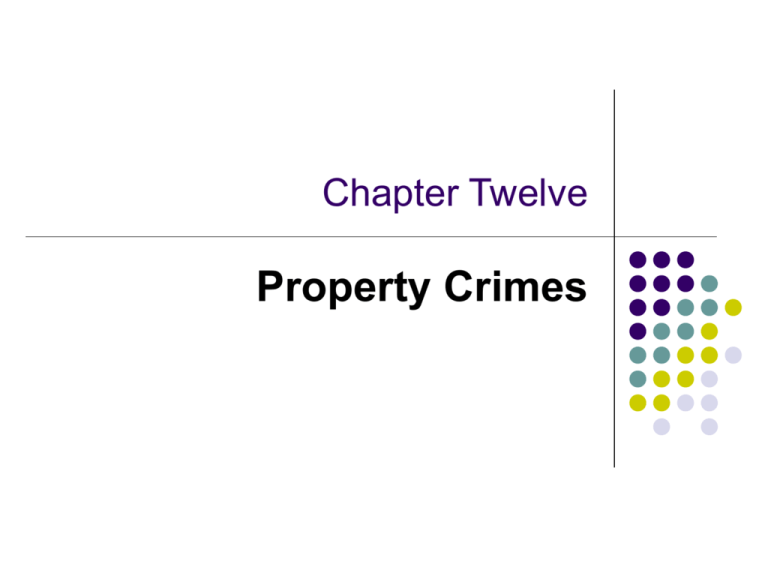
Chapter Twelve Property Crimes Objectives Be familiar with the history of theft offenses Recognize the differences between professional and amateur thieves Know the similarities and differences between the various types of larceny Understand the different forms of shoplifting Be able to discuss the concept of fraud Know what is meant by a confidence game Understand what it means to burgle a home Know what it takes to be a good burglar Understand the concept of arson Contemporary Theft Occasional criminals: are the ones who most often commit the crime, they do not define themselves by a criminal role or view themselves as committed career criminals Professional criminals: theft offenders who are skilled, make a significant portion of their income from crime The Professional Fence Earns his or her living solely by buying and reselling stolen merchandise They act as middlemen who purchase stolen merchandise—ranging from diamonds to auto hubcaps– and resale to merchants who market them to legitimate customers Conditions of Successful Fencing Up-front cash Knowledge of dealing—learning the ropes Connections with suppliers of stolen goods Connections with buyers Complicity with law enforcers The Occasional Fence A significant portion of all fencing is performed by amateur or occasion criminals Novice burglars such as juveniles and drug addicts Part-timers Associational fences Neighborhood hustlers Amateur receivers Larceny/Theft Taking for one’s own use the property of another, by means other than force or threats on the victim or forcibly breaking into a person’s home or workplace Petty larceny : involves small amounts of money or property and is punished as a misdemeanor Grand larceny : involves money or property of greater value and is punished as a felony Types of Larceny/Theft Shoplifting Bad checks Credit card theft Auto theft False pretenses or fraud Confidence games Embezzlement Shoplifting The taking of goods from retail stores Boosters or heels: a professional shoplifter who steals with the intention of reselling stolen merchandise Snitch: an amateur shoplifter who does not selfidentify as a thief but who systematically steals merchandise for personal use Strategies for Controlling Shoplifting Merchant privilege laws : legislation that protects retailers and their employees from lawsuits if they arrest and detain a suspected shoplifter on reasonable grounds Target removal strategy: displaying dummy or disabled goods while the real merchandise is kept under lock and key Target hardening strategy: locking goods in place or having them monitored by electronic systems Bad Checks Naïve check forgers: amateurs who cash bad checks because of some financial crisis but have little identification with a criminal subculture Systematic forgers: professionals who make a living by passing bad checks Credit Card Theft The use of stolen credit cards is a major problem in the U.S. society Most credit card abuse is the work of amateurs Some professional credit card rings are getting into this crime Auto Theft Motor vehicle theft is another common larceny offense, auto theft can be divided into the following categories: Joyriding Short-term transportation Long-term transportation Profit Commission of another crime False Pretenses or Fraud Misrepresenting a fact in a way that causes a deceived victim to give money or property to the offender False pretenses differ from traditional larceny because the victims willingly give their possessions to the offender, and the crime does not involve a “trespass in the taking” Confidence Games A swindle set up to separate victims from their money, many involving a get-rich-quick scheme, often with illegal overtones so that the victim will be afraid or embarrassed to call the police Some common confidence games include: Reading obituaries, then sending surviving spouse a bill Posing as a bank employee Pyramid schemes Shady contractors False invoices for ads Embezzlement A type of larceny in which someone who is trusted with property fraudulently converts it to his/her own use or for the use of others Most courts require that a serious breach of trust must have occurred before a person can be convicted Burglary Any unlawful entering of a structure to commit theft or felony It includes: forcible entry, unlawful entry where no force is used, and attempted forcible entry Those most likely to burglarized are relatively poor Latinos and African American families Because it involves planning, risk, and skill, it has been a crime long associated with professionals who know their craft Careers in Burglary The “good burglar”, use this title to distinguish themselves, some of the characteristics include: Technical competence Maintenance of personal integrity Specialization in burglary Financial success The ability to avoid prison sentences Arson The willful, malicious burning of a home, building, vehicle, or commercial building Motives: Severe emotional turmoil Disturbed personality Psychopathology Angry people looking for revenge Teenage vandalism Arson for profit and arson fraud To conceal another crime, such as embezzlement The Juvenile Fire Starter Most prolific fire starter, may get involved in arson for a variety of reasons, associated with psychological abnormality, including depression, conduct problems, such as disobedience and aggressiveness, anger, hostility, and resentment over parental rejection Juvenile Arsonists Juvenile arsonists can be classified in one of four categories: The “playing with matches” fire setter The “crying for help” fire setter The “delinquent” fire setter The “severely disturbed”
